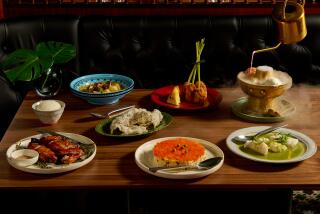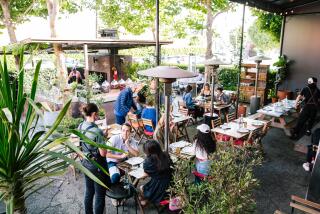Going Tropical on Malay East Coast
KUALA LUMPUR, Malaysia â I have come to believe that every country where a man cannot live naked in all seasons is condemned to work, to war, and to the hampering restraint of moral codes.
--R. H. Bruce Lockhart, Memoirs of a British Agent, 1932
My first impression of the east coast of Malaysia was that I had fallen, by happy mistake, into a kaleidoscope of the South Seas.
Here were the intense blue-greens of jungle, the shimmering beige-golds of beach sand shaded by bends of coconut trees and the translucent turquoise of the sea, above which floated little squiffs of lavender clouds: It was the tropics, sure enough, flavored by that intangible, floating fragrance of the East.
That was many years ago, when I learned the meaning of the Malay word jalan , in its singular form meaning a road or a street. When doubled, jalan - jalan , it takes on a less definite air: a stroll, a ramble, pleasurable wandering without a goal, going places just for the fun of it.
In the days of rubber planters, cricket and gin slings, of sola topees bought in Port Said to shelter the tender heads of civil service gentry out from England, only one skinny, red-soil road ran from the capital of Kuala Lumpur north along the coast.
The easiest way to travel was by coastal steamer that called at little trading ports frequently named Kuala-something (Kuala means river mouth or estuary).
Modern Highway
When I first drove the coastal route it was cut by wide, muddy waters crossed by frail-looking car ferries and dotted with little Malay kampungs , rural settlements of stilt-legged wooden houses.
Today you roll north in comfort along a wide, modern highway, easily making the Kuala Lumpur-Kuantan trip between breakfast and lunch, even if you stop in Temerloh to buy Kickapoo Joy Juice (believe it or not).
I recommend, however, a detour to the high-country resort of Fraserâs Hill, one of five escapes from heat created by the British. Leaving Kuala Lumpur, the road to Ipoh (No. 27) runs north through tiny, two-story towns outfitted with food stalls, hair salons, schools, figures of Popeye offering fried pork, SunTex tire stands, signs reading Polis and Teksi (forms of many English words have found their ways into Malay spellings), CalTex stations and car-repair shops.
Through the dim world of rubber trees you cruise, past padi fields with timeless figures bending their backs, up through a jungle of sun and shadow, gracefully nodding bamboo, giant ferns.
âWhat kind of tree is that?â I asked the driver.
âWild tree,â he answered.
âKindest Jungleâ
About the Malaysian jungle, a European adventurer, Sjovald Cunyngham-Brown, wrote: âThe Malayan jungle is the kindest jungle in the world; great hardwood trees, about 25 or 30 feet apart, and a dense cover of foliage at 250 to 300 feet above your head. Thatâs where the flowers are and where the birds and butterflies live.â
Jungle creatures are timid; usually you donât see them. I listened for the bird call that goes âroo, roo, roo--karoo, karoo--hah, hah, hah!â Itâs the call of the hornbill, which the Malays call the chop-down-your-mother-in-law bird.
Fraserâs Hill has about it the somnolence of a summer Sunday in the country. A few idle whackers stroll the golf course; others admire dahlias, roses, fuchsias, geraniums, gladioli. At the Merlin Hotel I lunched on spicy sambal udang and drank Anchor beer and watched clouds gather on the horizon, purple and pregnant with rain.
It began to pound down as we drove on. Sometimes in Malaysia, rain is a flat gray-white screen slicing across your view of the towns, the jungle, the road.
The skies had cleared before Kuantan; late afternoon light turned Beserah fishing villages into a tapestry of palms and high-prowed fishing boats (prahus) and tidy, stilted houses, all hung flat upon a gold-green backdrop--the South China Sea.
Exotic Hotel
The Hyatt Kuantan comes as a distinct surprise; first because a Hyatt is there at all and secondly because itâs so right. Set just back of a gleaming white beach, itâs tasteful, low-rise Malaysian in style, with Meranti softwood panelings, batik hangings, cane furniture, woodcarvings, open-air lobby. The pool has a swim-up bar, precisely what you want after a sticky day on the road.
Our first dinner in Kuantan was at Chee Shih, walking distance from the Hyatt, where several of us outlanders sampled a Chinese steamboat: a feast of seafoods dumped briefly into boiling water much in the manner of a Japanese shabu-shabu . Ingredients included bean curd, fish, abalone, seaweed, squid, fish balls, liver, cuttlefish, chicken and quail eggs (about $8 each).
The next night we dined at Hugoâs in the Hyatt on meticulously prepared continental dishes accompanied by fine French wines.
The drive from Kuantan to Kuala Terengganu took a whole day and was filled with delights: an exhibition by monkeys who climb trees and pick the coconut their trainer wants, a demonstration of the difficult art of top-spinning, a visit to the Club Mediterranee at Cherating, lunch at the smashing Tanjong Jara Beach Hotel.
Top-spinning in Malaysia is not a childâs game. In fact, children under age 16 are barred from village contests for fear that they may damage developing shoulder ligaments.
Nobody knows the origin of the art. Some aboriginal peoples say that lightning is the flashing of top cords in heaven and thunder is the murmuring of the spinning tops.
Heavy Topspin
Made of polished hardwood and rimmed with metal, tops can weigh as much as 15 pounds (the fighting tops) and stand twirling (and nearly motionless to the eye) for up to two hours. To get them started, with a tightly wound rope, takes tremendous strength and skill. Rural villages sport top teams, and the better the team is, the richer the rice harvest will be.
Kite flying isnât only for kids, either. Itâs partly traditional, partly mystical, and itâs a sport that probably arrived from China in the 14th Century. Competitions are keenest on the east coast, with the skies filled at times with moon kites, bird kites, cat kites--each with its role to play. During a full moon those outfitted with a bow-like device that hums are left flying all night to hum the children to sleep.
If you are lucky, somewhere along the east coast you will come across a performance of wayang kulit, the shadow puppet theater (also performed in Indonesia and elsewhere in Southeast Asia) that for more than a thousand years has enthralled audiences with tales from the Hindu epic, âRamayana. â The personalities on stage are said to be the shadows of their realities in heaven, and Prince Rama always wins. But how? That is the challenge.
Tourist offices in Kuantan and Kuala Terengganu can direct you to performances. When groups of foreigners arrive, special shows may be staged.
In Kuala Terengganu you stay at the handsome Pantai Perimula Hotel, admire the beautiful old sultanâs palace (across the street from his new one), use up all your film at the nearby fishing village of Marang, and soak up sights, sounds and smells at the central market.
If you have time, you pay a fisherman to ferry you to the offshore island of Perhentian for a day of picnicking, swimming and sunning.
Primordial Turtles
Some night, especially in July and August, you will skip sleeping in the hope of seeing giant leathery turtles lay their eggs on the beach at Rantau Abang. The spectacle is startling, primordial. The great beasts, up to 12 feet long, weighing in at up to 2,200 pounds and perhaps as old as a thousand years, lumber up the sands to deposit 100 or so eggs in holes they dig with flippers. The government restricts the collection and sale of eggs with strict punishments for offenders.
Farther north along the coast, the state of Kelantan, bordering Thailand, stars the town of Kota Baharu, a colorful place with palm-fringed beaches, all the arts and sports typical of this civilization, a riot of a market, a noted bird-singing competition in June, nearby waterfalls and lakes, cultural events that may be seen nowhere else in Malaysia and beautiful handicrafts.
This is the top of the coast. At twilight it may be time to stroll the white sands of Pantai Chinta Berahi, the Beach of Passionate Love, to feel the soft breezes and to watch the wavering casuarina trees that, the Malays say, will grow only within the sound of the surf.
Major hotels along the east coast, in addition to those described above, are the Perdana in Kota Baharu, the Merlin and Samudra in Kuantan and the Merlin Samudra on spectacular Pulau (island) Tioman, off the coast at Mersing.
Along the east coast, hotel room rates range from about $53 single to $90 U.S. double. In Kuala Lumpur, rates are higher.
Touring by car is the best solution for the east coast. Not long ago the east-west highway was completed, allowing driving across the peninsula from Kota Baharu to Butterworth.
The west coast is served by train. Air-conditioned buses are available, as are car rentals (driving is on the left). English is the widely spoken second language.
For assistance, write or call the Malaysian Tourist Information Center, 600 Montgomery St., San Francisco 94111; (415) 788-3344.
More to Read
Sign up for The Wild
Weâll help you find the best places to hike, bike and run, as well as the perfect silent spots for meditation and yoga.
You may occasionally receive promotional content from the Los Angeles Times.






